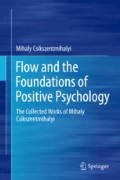Abstract
This chapter uses the Experience Sampling Method data drawn from a national sample of American youth. It examines the proximal environmental factors as well as behaviors and habits that correlate to personal happiness. Momentary-level scores show that reported happiness varies significantly both by day of week and time of day. Furthermore, particular activities are associated with varying degrees of happiness. School activities rate below average scores in happiness, while social, active and passive leisure activities are above average. Particular companions also correlate to differing level of happiness. Being alone rates the lowest levels of happiness, while being with friend corresponds to the highest. Person-level averages of happiness suggest that both higher social class and age correlate with lower levels of happiness, while gender and race do not. Paradoxically, youth who spend more time in school and social activities are happier than those who spend less. Unexpectedly, students who spend more time pleasure reading report lower levels of happiness. Finally, feeling good about the self, excited, proud, sociable, active as well as being in the conditions for flow experience are the strongest predictors of trait happiness.
Journal of Happiness Studies © 2003, Kluwer Academic Publishers. Printed in the Netherlands.
Access this chapter
Tax calculation will be finalised at checkout
Purchases are for personal use only
Notes
- 1.
This study was made possible by a grant from the Alfred P. Sloan Foundation.
References
Brickman, P., Coates, D., & Janoff-Bulman, R. J. (1978). Lottery winners and accident victims: Is happiness relative? Journal of Personality and Social Psychology, 36, 917–927.
Csikszentmihalyi, M. (1990). Flow: The psychology of optimal experience. New York: HarperCollins.
Csikszentmihalyi, M. (1997). Finding flow: The psychology of engagement with everyday life. New York: Basic Books.
Csikszentmihalyi, M. (2003). Good business: Leadership, flow, and the making of meaning. New York: Viking.
Csikszentmihalyi, M., & Schneider, B. (2000). New York: Basic Books
Csikszentmihalyi, M., & Schneider, B. (2001). Conditions for optimal development in adolescence: An experiential approach. Applied Developmental Science, 5(3), 122–124.
Csikszentmihalyi, M., Larson, R., & Prescott, S. (1977). The ecology of adolescent activities and experiences. Journal of Youth and Adolescence, 6(3), 281–294.
Csikszentmihalyi, M., Rathunde, K., & Whalen, S. (1993). Talented teenagers: The roots of success and failure. New York: Cambridge University Press.
Diener, E. (2000). Subjective well-being: The science of happiness and a proposal for a national index. American Psychology, 55(1), 34–43.
Graef, R. (1978). An analysis of the person by situation interaction through repeated measures. Unpublished Doctoral Dissertation, The University of Chicago.
Hektner, J. (in preparation). ESM Handbook.
Inglehart, R., & Klingemann, H. D. (2000). Genes, culture, democracy and happiness In E. Diener & E. M. Suh (Eds.), Culture and subjective well-being (pp. 165–183). Cambridge: The MIT Press.
Kahneman, D. (1999). Objective happiness. In D. Kahneman, E. Diener & N. Schwartz (Eds.), Well-being: The foundations of hedonic psychology (pp. 3–25). New York: Russel Sage.
Kubey, R. L., & Csikszentmihalyi, M. (1996). Experience sampling method applications to communication research questions. Journal of Communication, 46(2), 99–120.
Lykken, D., & Tellegen, A. (1996) Happiness is a stochastic phenomenon. Psychological Science, 7, 186–189.
Moneta, G., Schneider, B., & Csikszentmihalyi, M. (2001). A longitudinal study of the self-concept and experiential components of self-worth and affect across adolescence. Applied Developmental Science, 5(3), 125–152.
Patton, J. D. (2002). The role of problem pioneers in creative innovation. Creativity Research Journal, 14(1), 111–126.
Ryan, R., & Frederick, C. (1997). On energy, personality, and health: Subjective vitality as a dynamic reflection of well-being. Journal of Personality, 65(3), 529–565.
Schwartz, N., & Strack, F. (1999). Reports of subjective well-being: judgmental processes and their methodological implications. In E. Diener, N. Schwartz, & D. Kahneman (Eds.), Weil-being: The foundations of hedonic psychology (pp. 61–84). New York: Russel Sage.
Schmuck, P., & Sheldon, K. M. (2001). Life-goals and well-being. Göttingen: Hogrefe & Huber.
Seligman, E. P. (2002). Authentic happiness. New York: Free Press.
Tellegen, A., Lykken, D. T., Bouchard, T. J., Wilcox, K. J., Segal, N. L., & Rich, S. (1988). Personality similarity in twins reared apart and together. Journal of Personality and Social Psychology, 54, 1031–1039.
Veenhoven, R. (1995). The cross-national pattern of happiness: Test of predictions implied in three theories of happiness. Social Indicators Research, 34, 33–68.
Author information
Authors and Affiliations
Corresponding author
Rights and permissions
Copyright information
© 2014 Springer Science+Business Media Dordrecht
About this chapter
Cite this chapter
Csikszentmihalyi, M., Hunter, J. (2014). Happiness in Everyday Life: The Uses of Experience Sampling. In: Flow and the Foundations of Positive Psychology. Springer, Dordrecht. https://doi.org/10.1007/978-94-017-9088-8_6
Download citation
DOI: https://doi.org/10.1007/978-94-017-9088-8_6
Published:
Publisher Name: Springer, Dordrecht
Print ISBN: 978-94-017-9087-1
Online ISBN: 978-94-017-9088-8
eBook Packages: Behavioral ScienceBehavioral Science and Psychology (R0)

